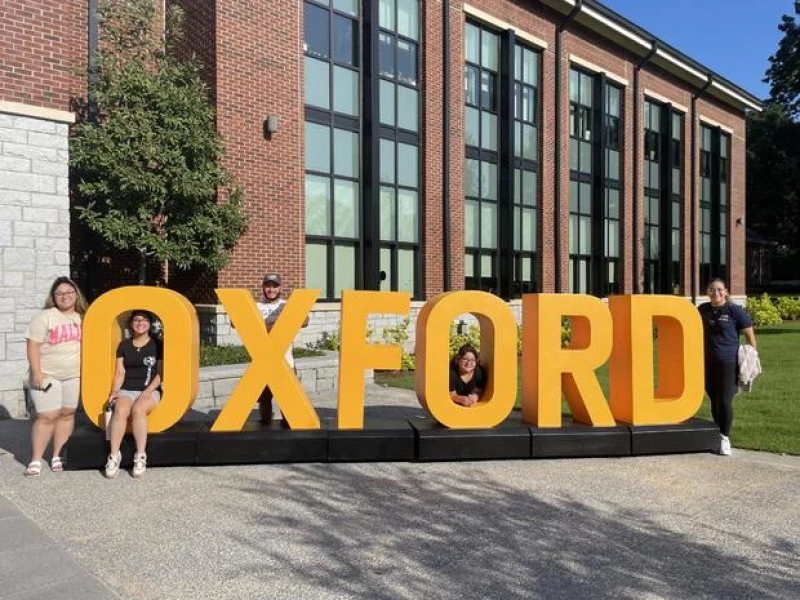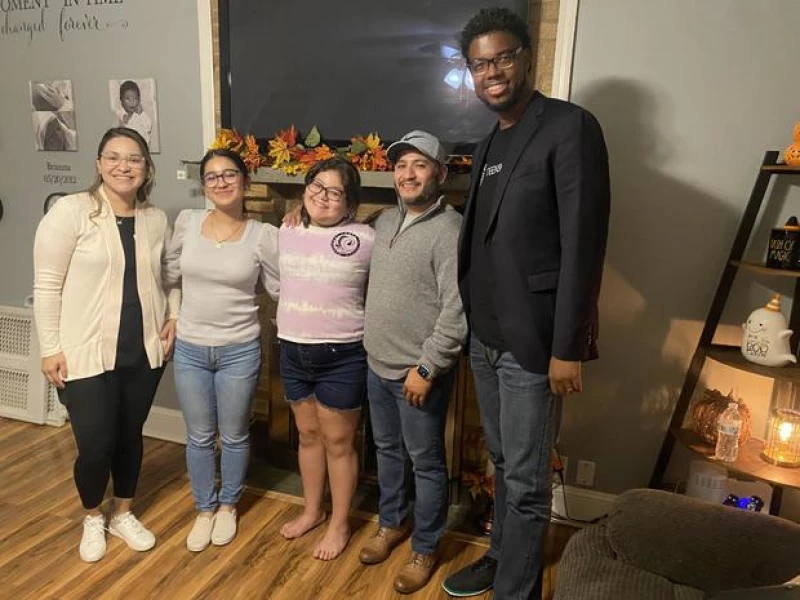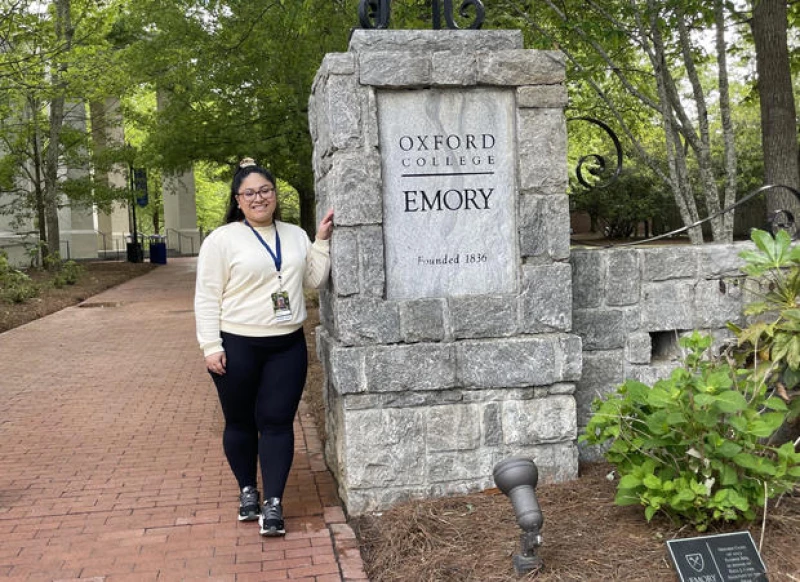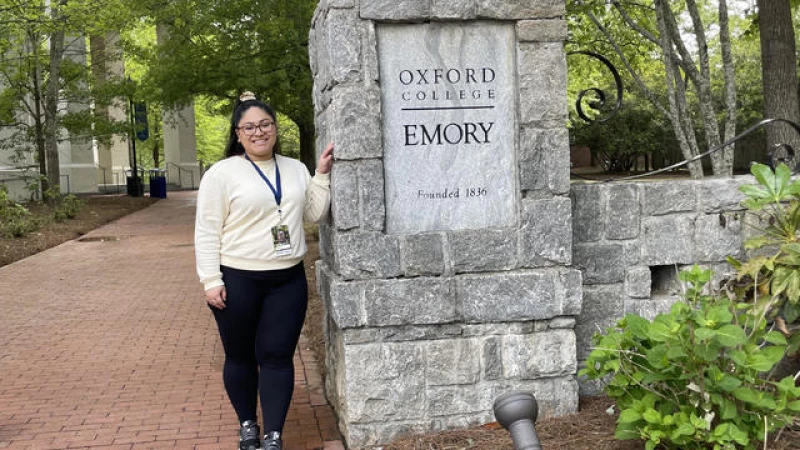Watch the CBS Reports documentary "The End of Affirmative Action"
WILMINGTON, Del. – A wall of the Rodriguez family home celebrates three seminal events with these words: "A moment in time, changed forever."
Beneath the inscription, a clock marks the time and dates when three swaddled newborns depicted in large photos entered the world: Ashley, now 19, Emily, 17, and Brianna, 11.
Another "moment in time" occurred last June, one that could change the paths of Emily and Brianna. That's when the U.S. Supreme Court ruled in its landmark case on affirmative action, barring colleges from taking race into consideration as a factor in admission decisions.
The ruling struck down more than 50 years of legal precedent, creating newfound uncertainty for the first class of college applicants to be shaped by the decision — especially for Black and Hispanic students hoping to get into highly competitive colleges that once sought them out.
It also places the Rodriguez sisters on opposite sides of history: Ashley applied to college when schools in many states could still consider race, while Emily can expect no such advantage.
The Impact of Court Decision on College Enrollment
Their parents, Margarita Lopez, 38, and Rafael Rodriguez, 42, are immigrants from Mexico who moved to the United States as teenagers.
Ashley is the first in her family to attend college, a freshman studying child psychology on a full scholarship to prestigious Oxford College of Emory University, where annual estimated costs approached $80,000 this year.
Emily is the middle daughter, a senior and mostly straight-A student at Conrad Schools of Science in Wilmington who wants to become a veterinarian, and who spent most of this fall anxiously awaiting word from her first-choice college, Cornell University.
The Test of College Diversity
The impact of the court's decision on enrollment at hundreds of selective colleges and universities won't start to become clear until colleges send out offers this spring and release final acceptance figures.
But many students, counselors and families view this admission cycle as the first test of whether colleges will become less diverse going forward, while cautioning it may take years before a clear pattern emerges. The Hechinger Report contacted more than 40 selective colleges and universities asking for the racial breakdown of those who applied for early decision and were accepted this year.
About half of the institutions surveyed did not provide the requested information regarding racial and ethnic composition, and some stated that they would not have access to such data until after the admissions cycle concludes next year. Legal counsel advised several institutions against releasing the information for the class of 2028.
For the Rodriguez family, higher education has already become a symbol of upward mobility, offering a life-altering path to meaningful careers and financial stability that Margarita and Rafael have never experienced.
College was not a part of their cultural background, and until last year, Rafael and Margarita were unaware of the complexity and competitiveness of the college admissions process for their bright and hardworking daughters. Among all racial and ethnic groups in the United States, Hispanic Americans are the least likely to hold a college degree.
"I never even imagined a school like Emory, or the many other schools that offer excellent financial aid," Margarita recently shared. If it weren't for TeenSHARP, a nonprofit organization that prepares high-achieving students from underrepresented backgrounds for higher education, she would have only considered local community colleges and state universities for her daughters.
She immediately enrolled Ashley in TeenSHARP, and later, Emily.
TeenSHARP co-founder Atnre Alleyne, along with his wife Tatiana Poladko and a team of advisors, guided Ashley and Emily in selecting their high school courses and writing their college essays. They also highlighted leadership opportunities and colleges known for offering scholarships.

College Admissions and Student Support
Emory University is one of the institutions that has made significant strides in diversifying its student population. While the school did not admit any Black students until 1963, it has since taken proactive measures to recruit students from underrepresented backgrounds. In recent years, Emory has seen a growth in Hispanic enrollment, with numbers increasing from 7.5 percent in 2017 to 9.2 percent in 2021. This trend was disrupted by a recent Supreme Court decision regarding affirmative action policies.
Ashley, a freshman at Emory, shared her experience of feeling welcomed and at home on campus. Despite being away from her family for the first time, she found support from her peers and the university community. However, she expressed concerns about adjusting to the academic workload and managing her grades. Ashley's sister, Emily, who shared a close bond with her, mentioned how much she missed her and joked about their complementary strengths in academics and communication.

This fall, Emily set her sights on some of the most selective colleges in the country, many of which had terrible track records on diversity even before the Supreme Court's decision. She approached her search knowing that she was unlikely to get any boost based on her ethnicity.
That makes her angry.
"We have so much history behind us as people of color," Emily said. "So why would we be put at the same level as somebody whose family has benefited off of the harm done to communities of color?"
Emily also knew she would need a hefty scholarship to attend one of her dream schools; her family can't afford the tuition, and they've been loath to saddle their daughters with loans.
Elite schools like those on Ashley and Emily's lists are more likely to be filled with wealthy students: Families from the top 0.1 percent are more than twice as likely to get in as other applicants with the same test scores. But such schools also offer the most generous scholarship and aid packages, and Emily and Ashley believed they presented the best shot at a different life from their parents'.
"Ever since I was little, I knew that college was the ticket to break this cycle our family has been in for generations and generations, of not knowing, of not being educated," Emily said. "And because of that, having to work with their backs instead of their brains."
It is remarkable that the Rodriguez sisters are even considering top-tier colleges, and their mother deserves credit for this achievement.
"I want them to have the opportunity I never had," Margarita said. "I know that life after education will be easier for them. I don't want them to be working 12, 14 hours like their dad did."
Rafael Rodriguez has always been a hard worker. As a child in central Mexico, he worked with livestock. Later, in Florida, he worked on an orange farm until the age of 15, with a residential permit. He used his earnings to help his family come to the United States and settle in West Grove, Pennsylvania.
Rafael did not have the opportunity to attend high school because he had to support his parents and sisters. However, he now owns a trucking company.
Margarita had a strong desire to go to college, but her mother did not believe in taking out loans for higher education and refused to sign her financial aid forms.
Instead, Margarita got married to Rafael a few days after graduating from high school and became a mother to Ashley a year later. Emily was born 17 months after that. Margarita had considered enrolling in community college, but then Brianna came along six years later. Currently, she helps Rafael with his trucking business and works as a translator.

Both sisters are acutely aware of the gap between their lives and their mother's. Ashley's college essay recounts the story of her parents, immigrants who embarked on a perilous journey from Guanajuato, Mexico, to America.
Emily, on the other hand, writes about how her mother, Margarita, defied the norms of their Mexican community, allowing Emily to sacrifice time with family on weekends and during the summer to attend Saturday leadership trainings with TeenSHARP. She also took college-level courses in epidemiology and health sciences at Brown, Cornell, and the University of Delaware.
Emily's experience of pressure is both significant and familiar to the immigrant journey, amplified by the divisive court ruling. Hamza Parker, a senior at Smyrna High School in Delaware, also feels this pressure. Initially, he was unsure whether to address race in his essay, a dilemma faced by many students.
In his majority decision, Chief Justice John Roberts stated that race could only be discussed within the context of the applicant's life story, leaving it up to students to decide if they would incorporate race into their essays.
Meanwhile, conservative activist Edward Blum, who helped bring the case before the court, has threatened more lawsuits and said he would challenge essays "used to ascertain or provide a benefit based on the applicant's race."
Hamza wavered at first, then rewrote his essay to describe his family's move to the United States from Saudi Arabia in sixth grade and the racism he subsequently experienced. He applied early decision to Union College in upstate New York; earlier this month, he learned via email that he did not get in.
Neither Hamza nor his father, Timothy Parker, an engineer, know why, or what role affirmative action played in Union's decision: Rejections never come with explanations.
Parker hopes his son will now consider an HBCU like the one he attended, Hampton University, in Virginia. He worries that if Hamza ends up at a school where he is clearly in the minority, he could be made to feel as though he doesn't belong.
Related: Beyond the Rankings: College Welcome Guide
"I'm letting it be his choice," Parker said, noting that Hamza might also feel more comfortable at an HBCU given the nation's divisive political climate. With the end of affirmative action, he added, "It feels like we are going backwards not forward."
HBCUs are experiencing increased competitiveness following a recent Supreme Court decision. Admissions director Chelsea Holley from Spelman College in Atlanta suggests that Black high school students may be choosing HBCUs out of concern for the potential erosion of diversity and inclusion, and because they believe they will feel more comfortable on predominantly Black campuses.
Parker is currently in the process of completing his applications to Denison University, the University of Maryland, the University of Delaware, and Carleton College. He is uncertain whether Hampton University will be included in his list of choices.
Alleyne, Hamza's advisor, expresses concern about the impact of the court's decision on other TeenSHARP seniors, although it is impossible to determine if the decision played a role in Hamza's rejection from Union. Alleyne also worries about the narrowing opportunities for students whose GPA does not fully reflect their brilliance and the challenges they have overcome.
Furthermore, Alleyne notes that scholarships previously available to students like Parker are disappearing. He mentions that some race-based scholarships, which his students applied for in previous years, are no longer listed on college websites.
On the other hand, there are those who view the court's decision as a necessary correction. Richard Kahlenberg, an author and scholar at Georgetown University who testified in the case, argues that the ban will create a fairer landscape for low-income students of all races.
Kahlenberg supports the use of affirmative action based on socioeconomic class rather than race. "I believe it's beneficial for poor individuals of any race to benefit from affirmative action," Kahlenberg stated.
Related: A prominent figure in protesting affirmative action now clarifies intent
The Rodriguez family eagerly awaited Cornell University's early decision announcement, marking the date on their refrigerator calendar as soon as it was known. Ashley, home from Emory for winter break, would be present to hear the news alongside her sister.
For weeks, the family had braced themselves for disappointing news: Cornell had recently announced that it was reducing the number of students accepted through the early decision track, as part of their efforts to promote fairness in the admissions process.
Nevertheless, Emily had spent a summer studying at Cornell and had developed relationships with faculty members and advisors. She had grown fond of the animal science program and the vibrant college town of Ithaca, nestled amidst breathtaking gorges and waterfalls.
"Let's do this, let's do this!" exclaimed Rafael as they gathered around Emily's laptop. Emily wore a white t-shirt with the bold red letters "Cornell" on the front, hoping it would bring her luck. After a moment of hesitation, she clicked the button.
"Congratulations, you have been admitted to the College of Agriculture and Life Sciences: College major: Animal Science at Cornell University for the fall of 2024. Welcome to the Cornell community!" said the email on her screen, adorned with red confetti. Annual estimated costs for next year would be $92,682 — but Cornell pledged to meet all of it.
Emily screamed, and the room erupted in cheers. Every member of the family began sobbing. Cinnamon, the family's three-year-old Cavalier King Charles Spaniel, barked wildly.
Emily jumped up and down. "Ivy League!" she shouted. "Oh my God, oh my God, oh my God. I did it."
Brianna, a sixth grader who will work with TeenSHARP once she's in high school, hugged both of her sisters.
It will be her turn next.
This story about the end of affirmative action is the second in a series of articles accompanying a documentary produced by The Hechinger Report in partnership with Soledad O'Brien Productions, about the impact of the Supreme Court ruling on race-based affirmative action. Hechinger is a nonprofit, independent news organization focused on inequality and innovation in education.







